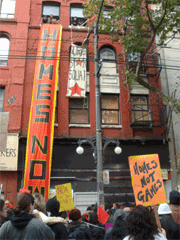
When poverty experts warn that homeless Canadians will likely outnumber Olympic athletes in Greater Vancouver during the 2010 Winter Games, part of their calculation is based on the swelling number of regional residents living just one fumbled paycheque away from the street. From Bowen Island to Langley, there are an estimated 126,000 such people at risk of homelessness.
At the deep end of that risk pool are the 5,000-plus denizens of the Downtown Eastside's notorious residency hotels, also known as SROs. After quietly sheltering British Columbia's shabbiest population for decades, investors have begun acquiring these historic Victorian abodes for redevelopment.
Up to 600 Vancouver SRO rooms were lost in the past year, either to rent increases or redevelopment-oriented evictions, according to a survey by the Carnegie Community Action Project. And with SRO vacancy rates close to zero, nearly every lost room translates into another Canadian pushed from "at risk" into bona fide homelessness.
One in 17 at risk
Using data from the 2001 Census and the Canada Mortgage and Housing Corporation, the Greater Vancouver Regional Steering Committee on Homelessness estimated that there were 126,515 people living in 56,215 households at risk of homelessness in 2001. Because of a math error by Statistics Canada, that estimate may have been a few percentage points too high; but even under a revised calculation, roughly one in every 17 residents of Greater Vancouver is living at risk of homelessness.
The definition of "at risk" is twofold: Households must spend more than half of their income on shelter, and must live in an inadequate dwelling.
"The average at-risk renter household paid two-thirds of its income towards shelter costs, and this payment goes towards housing that is either overcrowded or in poor condition," found the GVRD committee. "At-risk renter households almost certainly need to give up other necessities, such as food and clothing, to pay their rent."
Single-parent households relying on one source of income were found to be particularly vulnerable. People living in families with children accounted for 61 per cent of the at-risk population. Among lone parent families at-risk of homelessness, 87.5 per cent were headed by women.
Visible minorities were also overrepresented in the at-risk population, accounting for half of people in at-risk households. (By comparison, visible minorities made up 37 per cent of the regional population in 2001.) People identified as Chinese were the largest group among the at-risk population.
Though the census bulletin focused solely on economic factors, the committee noted that at-risk families and individuals are often pushed into homelessness by non-economic events, such as health problems or family violence.
Youth exiting the foster care system face one of the highest rates of homelessness, with more than half of street youth flowing from the foster care system. Likewise, individuals completing drug treatment programs, as well as those being released from jail or long-term hospitalization, are at high risk of becoming homeless.
Crossroads of the British Empire
The most concentrated population of Canadians at risk of becoming homeless live in the shadow of BC Place -- the venue at which Olympic organizers plan to hand out medals in 2010 -- in Vancouver's rough-and-tumble Downtown Eastside. More than a third of the neighbourhood's 16,000 residents are addicted to alcohol or drugs. A fifth suffer from mental illness. Collectively they share the lowest average annual income of any urban postal code in Canada, and one of the highest rates of HIV infection in the developed world.
Paradoxically, the Downtown Eastside has -- until recently -- boasted an unusually low rate of homelessness for a population so riddled with social problems. Why?
Because the neighbourhood was also home to Canada's largest concentration of residential hotels. The old hotels, often known as SROs (for single room occupancy), are the legacy of a time when Main and Hastings was a crossroads of the British Empire.
Only a century ago, nearly anyone who visited Vancouver either came or went by steamship. Coastal ferries such as the Pacific Princesses carried most of the traffic, while ocean liners such as the legendary Empress Line provided a fast connection from the western terminus of the Canadian Pacific Railway to the Orient. The globetrotting Londoner on his way to Hong Kong and the fortune-seeking stowaway from Seattle had one thing in common: they each spent a night in Vancouver.
Hundreds of hotels and rooming houses were built within walking distance of the piers that bristled along Burrard Inlet's southern shore. The cheap rooms huddled to the east, in what became vibrant Chinese and Irish neighbourhoods. Posh hotels were erected near the grand Carnegie Library and the ornate vaudeville theatres at what was then the city's epicentre: the corner of Main and Hastings.
Downtown moved west early in the 20th century. The Empress liners were pressed into use as troop carriers during World War II, and never returned to trans-Pacific service. Travellers began flying across the ocean in the 1950s. And in 1958, streetcars stopped serving the Downtown Eastside. Grand old hotels like the Balmoral and the Washington, which had once stood along the route to anywhere, were suddenly the middle of nowhere.
Roach-infested 'safety valves'
In Toronto, as in most North American cities, old hotels like these were bulldozed during the 1960s and '70s as part of a so-called "urban renewal" movement that razed minority neighbourhoods to build freeways. In Vancouver, the aborted Georgia Viaduct, which demolished the African-Canadian district known as Hogan's Alley, still looms over what remains of Chinatown like a Dadaist monument to the era.
Vancouver's SROs were spared, not by any foresight on the part of City Hall, which fled the neighbourhood in 1936, but by an unruly crowd of loggers, miners and seamen who fought for a cheap place to retire. New tenancy laws stalled the wrecking balls that demolished SROs to the south, and fire codes spared Vancouver's residential hotels from burning at the rate they did in northern communities.
Through subsequent decades, the surviving SROs graciously absorbed one social problem after another. Psychiatric patients joined the retired resource workers in the 1970s, as a result of widespread de-institutionalization. Cocaine arrived in the 1980s after police pushed dealers out of the West End during Expo '86. Crack came in the '90s, and crystal meth in the '00s, luring new generations into addiction.
Downtown Eastside SROs remain rough places. Four out of five rooms have bed bugs, cockroaches, and fire code violations according to a report released by the Vancouver Foundation in March. The 54 SROs studied by the Hotel Analysis Project generated a combined total of 11,269 emergency service calls in 2005. That's almost three calls per room.
But they are relatively cheap. The average monthly rent was $361 in 2005, according to the city's 2005 Survey of Low-Income Housing in the Downtown Core, which identified 139 residential hotels and rooming houses -- 122 of which were in the Downtown Eastside.
"We were lucky," said Mark Townsend, who directs the Portland Hotel Society, which manages about 500 housing units spread among several refurbished SROs. "These old buildings were huge safety valves. Places like Toronto didn't have that."
Last call at the old hotel
Only one of the former vaudeville theatres remains -- playing pornos -- and the legendary crossroads is now derided as the corner of Pain and Wastings. But at least 100 of the old hotels and rooming houses built to bivouac British globetrotters continue to shelter Canada's most vulnerable citizens.
An estimated 10,000 SRO rooms remained in the Downtown Eastside as late as 1970. The 2005 city survey found only 5,000. That's an average loss of 200 rooms per year. Fire was a leading culprit two decades ago. Closure was a problem in the 1990s. And conversion to budget hotels, such as so-called "backpacker" lodges, was the leading cause of SRO loss as recently as 2005.
In the past year, redevelopment has emerged as the latest leading cause. At least 22 SRO hotels traded hands during last year's real estate buying binge, with a combined total of 1,178 rooms.
About half that many were lost to evictions or rate increases during 2006, according to a count by the Carnegie Community Action Project. If that number is correct, and if the Downtown Eastside continues to lose 600 SRO units a year, the neighbourhood most at-risk of homelessness will lose half if its 2005 SRO stock by the day the 2010 Winter Games commence at BC Place.
Judy Graves, who works for the city's Housing Centre, disputed Carnegie's count of 600 units lost last year. But the founder of Vancouver's award-winning homeless outreach program agreed that from this point forward, each SRO loss will spawn more homelessness.
"We've hit zero vacancy," Graves said. "There are simply no rooms left. As more of the cheaper housing is destroyed, we are going to find more people in the street, because they have nowhere else to go."
Related Tyee stories:
- More Homeless than Athletes in 2010
Can Vancouver's Olympic pride be saved? First in a series. - Shovelling with Mayor Sam
Stalled homeless units finally jarred loose. Pols scramble for credit. - Province Snaps Up Poverty Hotels
Plan to protect housing catches insiders off guard.
















Tyee Commenting Guidelines
Comments that violate guidelines risk being deleted, and violations may result in a temporary or permanent user ban. Maintain the spirit of good conversation to stay in the discussion.
*Please note The Tyee is not a forum for spreading misinformation about COVID-19, denying its existence or minimizing its risk to public health.
Do:
Do not: